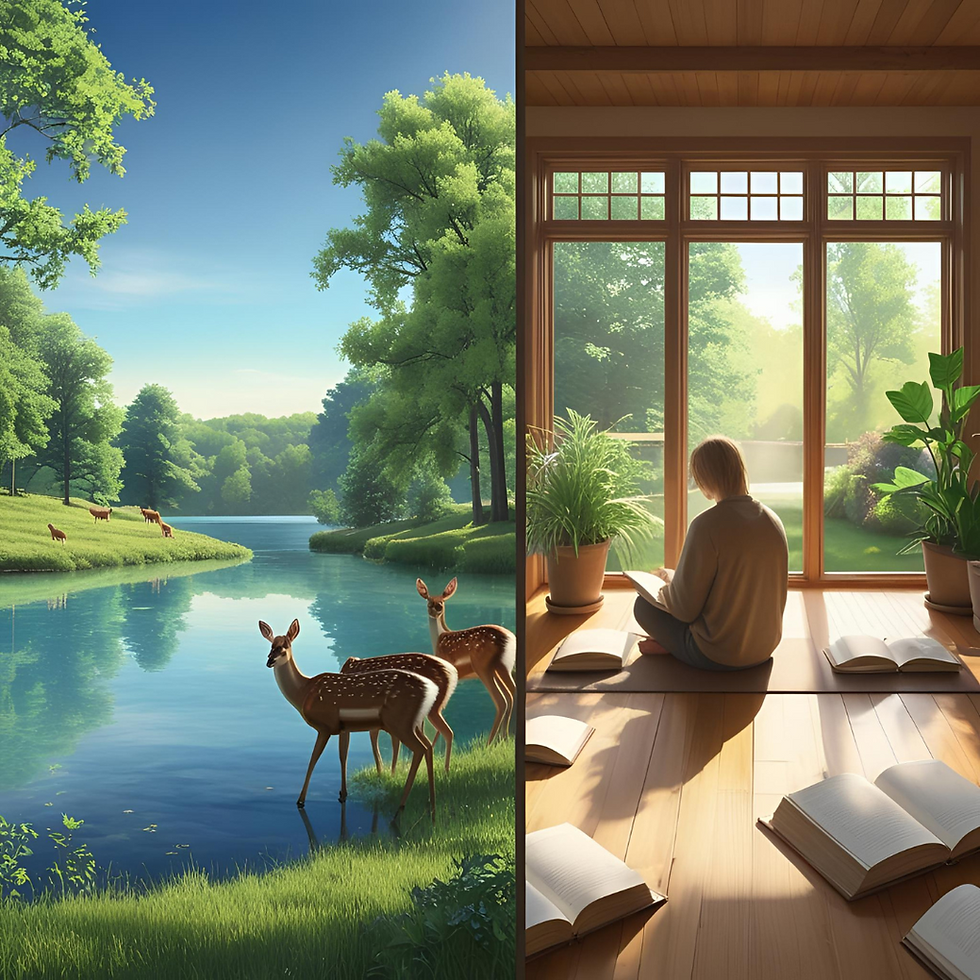Your Life Ecosystem Matters: Why Connection, Environment & Patterns Shape Your Well-being
- kyliet303
- Jul 7
- 6 min read
While pursuing my degree in health sciences, I had the opportunity to take numerous biology courses. My general biology classes allowed me to step outside the human lens and study life from nature’s perspective. We mapped out natural ecosystems and examined how all elements, seen and unseen, worked together to form a thriving whole. Occasionally, we zoomed in on the human role in these systems, and that’s when a realization began to take shape: society itself is our human-made ecosystem. And if we zoom in even further, each of us lives within our own personal ecosystem, comprising the various aspects of our lives that continually interact and influence one another.

That was the first time I truly grasped the interconnectedness of our planet and ourselves. Every choice we make, no matter how small, echoes across the different layers of our lives. Our personal ecosystem encompasses both our inner world, our thoughts, feelings, beliefs, and behavioral patterns, and our outer world, which includes our environments, relationships, and daily surroundings. We each have a choice: will we be in the driver’s seat of our lives, consciously shaping this ecosystem? Or will we stay in the passenger seat, hoping things work out on their own?
Being in the driver’s seat isn’t always the easy route. But it’s how we cultivate the most important relationship we’ll ever have: the one we have with ourselves. When we’re not present, intentional, and aware, we’re unconsciously handing others the power to shape our life ecosystem for us.
Let me offer an example. I’ve been working with a client on spiritual development for the past few months. As part of our first session, we reviewed their life using the lens of the wellness dimensions and explored how these areas were interacting. Though they had come in wanting to focus on spirituality, the conversation naturally centered around the physical, emotional, and social realms. Just before we wrapped up, they apologized for not getting into their spiritual growth like they had hoped.
I gently reassured them: “Actually, we did talk about your spirituality. We brought awareness to the parts of your life that are draining your spirit, and you chose action steps to rebalance those areas. That is spiritual work, even if it doesn’t feel like it yet. Just pay attention to how you feel in your daily rituals over the next few days.”
By our next session, their whole energy had shifted. “You won’t believe this,” they said. “After just a few days of tending to my emotional and physical health, I had this incredible meditation! I connected with this beautiful gold ball of energy. I’ve never experienced anything like that.”
It was exciting—but not surprising. When we care for the full ecosystem of our life, by tuning into our needs, balance becomes the foundation, and expansion becomes possible.
🧠 THE SCIENCE & PSYCHOLOGY
Why Connection, Environment, and Patterns Impact Everything
While the idea of a life ecosystem may sound poetic, it’s deeply rooted in science. The way we feel, function, and flourish is influenced not just by internal willpower but by the external and relational conditions we live in every day. Here’s how each layer of your life ecosystem makes an impact:
1. Connection: The Biological Need to Belong

Humans are social creatures by design. From infancy, our nervous systems are wired to seek connection through co-regulation, by receiving calming signals from safe and attuned individuals. Oxytocin, the bonding hormone, lowers stress levels, improves heart health, and even boosts immune function. Whether it's close relationships, casual social interactions, or even a connection with pets or nature, the relational part of our ecosystem directly affects how safe or threatened our body feels.
When supportive connection is lacking, the body may remain in a state of low-grade survival. This doesn’t just influence emotions; it can suppress immune function, disrupt sleep, and increase the risk of chronic disease. Connection needs aren’t just about having a ton of friends; it’s about having relationships that provide you the safety, non-judgment, and acceptance to be your authentic self within the community. The quality of your connection with humans, other animals, and nature is more important than the quantity.
2. Environment: Sensory Input and Nervous System Regulation

Your brain is constantly scanning your environment to assess safety or danger. A cluttered, overstimulating, or chaotic space can subtly keep your nervous system in a heightened state. In contrast, calming surroundings, natural light, soothing sounds, plants, and order, can support regulation and recovery.
It’s not just physical environments either; digital spaces count. Constant exposure to stressful news, online arguments, or overstimulation from social media can fragment your focus and contribute to emotional dysregulation.
3. Patterns: Habits and Emotional Cycles That Reinforce Themselves
Every repeated behavior, thought, or coping mechanism reinforces a neural pattern. If we’re consistently reacting to stress with avoidance, distraction, or emotional suppression, those patterns grow stronger and more automatic. Over time, this can shape not just how we act, but how we see ourselves and our potential.
Healing begins when we create enough safety and awareness to pause, observe, and rewire. This is where mindfulness, nervous system work, and compassionate reflection come in; they interrupt automatic patterns and open the door for intentional change. Every time you interrupt an automatic pattern, you are creating and strengthening new neural pathways.
🔍 PRACTICAL REFLECTIONS
Tend to Your Life Ecosystem, One Layer at a Time
Improving your ecosystem isn’t about overhauling everything overnight. It’s about tuning in, becoming more conscious, and making small shifts that ripple outward. Here are some gentle prompts to explore each layer of your life ecosystem:
🌿 Connection
Who brings out the best in me?
Where am I craving more connection, emotionally, socially, or spiritually?
Are my current relationships nourishing, draining, or neutral?
Could time with pets or time in nature help me meet connection needs?
🏡 Environment
How does my home or workspace make me feel when I walk into it?
What can I remove or rearrange to reduce overwhelm or distraction?
Am I exposed to too much noise, clutter, or digital stimulation?
What small sensory changes would help me feel more grounded?
🔁 Patterns
What do I tend to do when I’m stressed, overwhelmed, or overstimulated?
Are these coping strategies helping me feel better in the long run?
What emotion or need might be under the surface of that behavior?
What’s one pattern I’m ready to shift, even if it’s just a little?
✨ EMPOWERMENT & INTEGRATION
Co-Creating a Life That Nourishes You
Tending to your life ecosystem isn’t about control; it’s about co-creation. It’s the process of walking alongside yourself with awareness, self-respect, and compassion. When you recognize that your energy, environment, relationships, and habits are all part of a larger whole, you begin to step into a more empowered, integrated way of living.
And it doesn’t have to be overwhelming.

You don’t need to fix everything at once. In fact, small, intentional changes often lead to the greatest shifts over time. Choose one place to begin, maybe it’s clearing a cluttered corner, initiating a vulnerable conversation, or choosing to pause before falling into a familiar pattern.
Remember: building a healthy life ecosystem isn’t a destination, it’s a rhythm. One that moves with you as you grow, shift, and discover what truly supports your well-being.
When we approach our life this way, with gentleness and intention, we not only create more balance, but we also allow our energy to expand. We reconnect with our clarity, our creativity, and our power to choose what comes next.
🌱 CONCLUSION: Coming Back to Wholeness
When you zoom out and look at your life as an interconnected ecosystem, you begin to understand why certain changes feel harder than others and why some shifts unlock growth in unexpected places. It’s not that you’re doing things wrong; it’s that life requires alignment, not perfection.
This week, I invite you to gently observe your life ecosystem. Where do you feel supported? Where might something be out of balance? What small change could begin to create more flow?
Whether it's setting boundaries in relationships, restructuring your environment to reduce overwhelm, or choosing new responses to old patterns, your choices matter.
And when you start building from that place of alignment, everything changes.



Comments